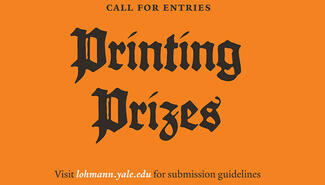Librarian helps Senior Exhibit Fellow navigate an unusual collection
For five weeks this summer, Senior Exhibit Fellow Chucho Martinez Padres ’23 took up the archival trail of art historian George Kubler, PhD ’40. Kubler was professor of the history of art at Yale from 1938 to 1983. He also received his bachelor’s (1934), master’s (1936), and doctorate (1940) from the university, and his papers are in Yale Library’s collections. Martinez Padres discovered a treasure trove there: a “miminally processed” collection containing 111 boxes of unexplored or underused material. The holdings, acquired over time in batches, had been informally organized by Kubler’s librarian during the 1980s and 1990s. Martinez Padres finds this fact telling in itself. “To see the narrative already built into the archive, the different layers the archive has,” Martinez Padres says, “is part of the story.”
Overcoming Obstacles
“Minimally processed” means that there is just a very general box-level description of the materials as opposed to the researchers’ preferred folder-level description—a potential barrier to working with such a large and varied collection, particularly within only a five-week window. “I rarely knew what to expect to find in each box,” Martinez Padres says.
Fortunately, he had invaluable help in overcoming this obstacle from his librarian advisor Jessica Quagliaroli, architecture records archivist in Arts Library Special Collections. Working often only with a one-line description, Martinez Padres would notify Quagliaroli of his potential interest in a box’s content. She would sort through the box in advance, “foldering” the material so as to make it more useful for him to study later. “Sometimes,” he explains, “I would work with one box for two full days. Sometimes I could go through three boxes in a day. Jessica’s flexibility and availability as my librarian advisor was crucial in accommodating the irregular pace of my research.”
Quagliaroli previously held the position of archivist for the Architect of the Capitol, where she arranged and described agency records, answered reference requests, and assisted in the implementation of a agency-wide records management program. Kerri Sancomb, Yale Library’s exhibition program manager, paired Quagliaroli with Martinez Padres to serve as his librarian advisor throughout his fellowhip.
“The role of the librarian advisor,” Quagliaroli says, “is to be a guide for the student. The student is the one driving the research, but archival research is not an intuitive process all the time. No one is born knowing how to to do that work; it is an acquired skill. So the librarian advisor is there to help with any roadblocks, any barriers, any issue that the student might be having navigating collections and prioritizing what to research, what to look at.”
Kubler’s Unique Archive
Martinez Padres found the inspiration for his fellowship project in Kubler’s book The Shape of Time: Remarks on the History of Things (1962). Kubler is also the author of Mexican Architecture of the Sixteenth Century (1948). Martinez Padres, who was born in Mexico City, was drawn to Kubler’s exploration of early colonial monasteries in Central Mexico, which combine diverse architectural traditions. Working in the archives, he says, “freed me from the finality of published texts and helped me contextualize and humanize Kubler’s work.
“One of the things that we talked a lot about,” Quagliaroli adds, “was the fact that the archive really reflects Kubler’s work and Kubler’s process. Kubler’s work was very conceptual, which means his archive is also very conceptual. And that’s not very typical. There are not a lot of collections that are like that, especially architectural collections. They tend to be cut and dried—’these are the projects, this is the research.’ Or, if it’s the collection of an architectural historian and critic, like Kubler was, it would be very much ‘these are the research files, these are the photographs’—pretty linear.
“Kubler’s collection is all over the place because Kubler was all over the place,” she adds. “I really encouraged Chucho to lean into that. And to think of the archive as a reflection of Kubler. And so, instead of seeing that as a challenge to his research, what could he learn from that, what could he glean from that? I encouraged him to think of the archive as a collage, and when he’s putting hs essay together, when he’s putting the exhibit together, to take pieces here and there, from all over, and put them together for his audience.
Martinez Padres, an architecture student, is conducting his research not only for his senior essay but also for the student exhibition that he will curate, to open in Sterling Memorial Exhibition Corridor next spring.
“Research at this scale can be tricky for anybody, even the most seasoned researcher. It can sometimes be an unwieldy process that gets away from you, so asking a student, even a rising senior, to do that type of research is a big ask. As a librarian advisor that was one of the areas where I could really help guide Chucho to think through what does it look like for him—not necessarily proscribing a process but helping him think through what is helpful for him and what is going to be helpful for him when he writes his senior paper and when he puts the exhibition together.”
In addition to receiving guidance from Quagliaroli, throughout his fellowship Martinez Padres will also have the assistance of Surry Schlabs, critic and Director of Undergraduate Studies in the School of Architecture. Sancomb and Sarah Davis, the library’s exhibits technician, will work closely with Martinez Padres on the planning and installation of his senior exhibit.
This year’s Yale Library Senior Exhibit Fellowship is the first to include a funded summer research experience on campus in the library’s collections.
Read more about the Senior Exhibit Fellowship and Martinez Padres’s fellowship project.
Photo and story by Deborah Cannarella



